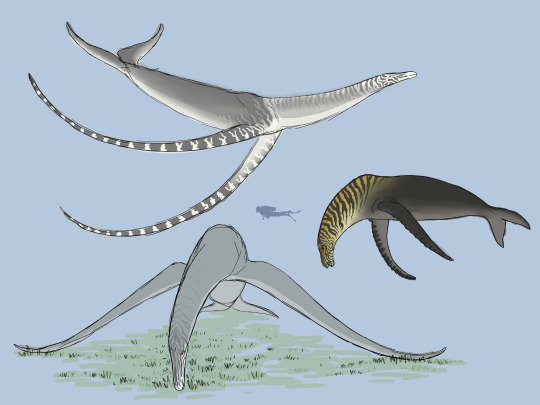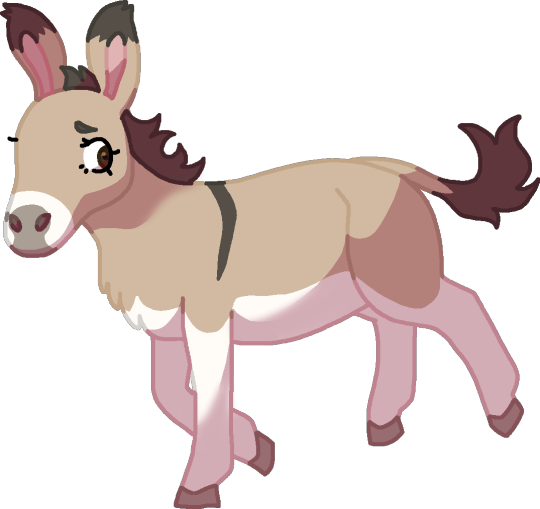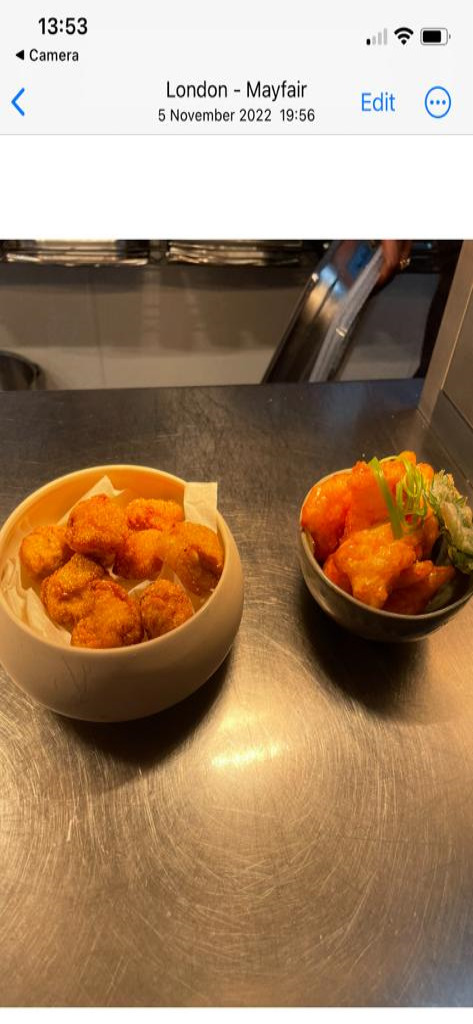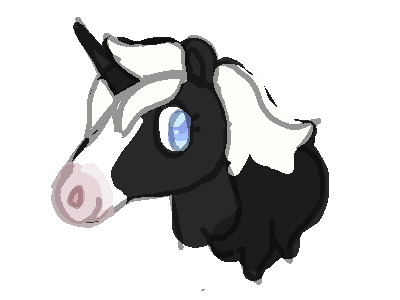#equid
Text

the baby has one parent's little face marking thing and the other's coat because they're a little horse family the world is a beautiful place
#☆#might become really obsessed with horses i'm not sure yet#maybe specifically mustangs and other feral horses... They intrigue me deeply#update i've been informed the thing is called a blaze but i just described it instead in the alt text bc i think clarity matters more than#erm. specificity??#also sorry if i don't know what colour the horses are. someone tell me if u like i like this stuff#🐯#domestic horse (equus ferus caballus)#equid#juvenile#top
59K notes
·
View notes
Text

Some sketchy concept stuff that I'm posting because I liked it but couldn't be bothered to refine it into an actual artwork.
These submarine behemoths are the Mermares (Clade Euhippocampiformes), secondarily aquatic descendants of the domestic donkey. The group first appeared around 29 million years post-cataclysm, in the late Nerian stage of the Diluvian period. They evolved from an animal called the Seabra, a descendant of the Donkey which adapted to exploit a niche with, thus far, zero competition - that of a large marine herbivore.
On earth, marine ecosystems are notable for the distinct lack of vascular plant life, a condition caused by a number of factors - most notably the osmotic stress caused by the saltwater. Most photosynthesis is carried out by algae. On Spero, however, things are different. Because Spero's oceans were generated relatively recently, from extraterrestrial ice particles, there just hasn't been enough time for erosion and the water cycle to deposit dissolved minerals in the water. As a result, Spero's seas are made of freshwater - a much more tolerable condition for most plants, and thus the diversity of marine vascular plants is much, much higher than on earth. Also, due to the flatness of the flooded landscape and lack of any real tectonic features, enormous swathes of the seabed lie within the photic zone, less than 200 meters from the surface. Thus, endless expanses of marine grasslands - the "seagrass prairies" - extend from the shore, often for hundreds of miles before the water finally gets too deep for photosynthesis to occur.
All of this plant life is an extremely attractive prospect for herbivores, and it was likely what drew the ancestral Seabra to forage in shallow coastal meadows in the first place. But as the oceans got deeper and life adapted, the Seabra had to adapt in kind - their hind legs rotated backwards to act as a pair of propulsive flukes, their forelimbs developed into steering flippers, and their nostrils retreated to sit on their foreheads.
One notable feature of the Mermares is hyperphalangy, a condition where the fingers have too many bones. It's very common in large marine tetrapods in Earth's history - whales and dolphins, Ichthyosaurs, Plesiosaurs, and Mosasaurs all exhibited hypoerphalangy to some degree - and seems to be associated with the specialization of the limbs into flippers. We would expect to see similar patterns in marine lineages on Spero. What's unique about the Mermares, however, is the sheer number of extra phalanges in the finger; at least fifteen in the shorter-finned species, and more than thirty in the longest-finned forms. And because Mermares - being equids - only possess one digit per limb, the result is a single long chain of flat, squarish bones which, in some cases, can reach over forty feet long - the longest arms ever to exist.
These ridiculous appendages produce a lot of drag and are merely adequate for steering and stabilization. So why do the Mermares have them?
The answer is that they're weapons. And particularly devastating ones, at that.
Mermares use their flagellating flippers as bludgeons, against both predators and conspecifics. The flippers are connected to powerful neck muscles and can be swung forward with impressive force; combined with a well-timed twisting of the giant horse's torso, the huge flippers can impact hard enough to shatter bone and pulverize flesh. The flippers themselves do not escape unscathed, and older individuals often have scarred or mangled flipper-tips from numerous battles over the years; but it's a small price to pay for survival.
When not being used against their enemies, the flippers may be folded back against the sides of the animal to reduce drag, or used as props to keep the animal's belly up off the seabed when feeding. Mermares spend up to 18 hours per day grazing, using their long neck to crop aquatic grasses and other vegetation in a wide arc without moving their bodies and occasionally dipping up to the surface to breathe. Mermares are keystone species in the seagrass prairies; as hindgut fermenters, they are not as efficient at processing plant matter as ruminants like goats, and produce large amounts of nutrient-rich dung which acts as fertilizer for the meadows and helps keep the environment productive. The dung also acts as food for a variety of fish and invertebrates.
Let's look at some of the Mermare's diversity, shall we?
Drepanarion (center right)
One of the smaller Mermares, Drepanarion nonetheless grows to nearly 12 meters (39 feet) long. It is immediately recognizable by the bold black-and-yellow striping on the heads and necks of the stallions, and by the tall, narrow nuchal crest which extends from the withers and makes the stocky body look even more powerful. Unlike most other Mermares, which live in small groups of less than ten individuals, Drepanarion can be found in herds of over a hundred in the seagrass prairies of the Savanian (41 - 50 million years post-cataclysm). These nomadic throngs graze patches of seagrass nearly to the roots before moving on, giving the ecosystem time to regrow before returning in a few years' time. Drepanarion exhibits the most extreme sexual dimorphism of any Mermare, with stallions being both larger and more brightly coloured than mares; during the annual rut, males will fight each other in brutal bludgeoning matches to establish dominance and secure mates. To this end, they have some of the most extreme flipper anatomy of any Mermare; though not especially long (indeed, they have the shortest flippers of any derived genera), each phalanx bone has a protruding bony tubercle on the anterior edge which extends into a keratinous knob. These knobs both protect the flipper during combat and focus the force of the blow into a smaller area, dealing more damage.
Hipposeidon (bottom left)
First appearing in the early Imberian (50 million years post-cataclysm), Hipposeidon is the largest of all Mermares and, indeed, the largest animal ever to exist on Spero, with stallions regularly reaching over 24 meters (80 feet) long (mares are slightly smaller). Extremely large specimens may even reach 30 meters (100 feet), although this is rare. This ludicrous size - nearly rivaling even the mighty Blue Whale of Earth - is possible only due to the sheer abundance of its food. Hipposeidon appears at the height of the seagrass prairie's extent, and can pack away almost 900 kilograms (1900 pounds) of seagrass per day. This superlative food requirement has important consequences for Hipposeidon's behaviour; this animal is migratory. Seagrass prairies are extremely productive ecosystems, but nonetheless Spero is a seasonal world; as the summer growth gives way to the winter die-back, the greatest of the Mermares must migrate across the equator to seek out a continuous food source to fuel its immense bulk. In this way Hipposeidon experiences a perpetual summer, interrupted only by the biannual migration from north to south and back again. Female Hipposeidon are pregnant for about one year, timing the birth of the single large foal with arrival to the feeding grounds; the six-meter-long foal enjoys a long childhood nursing and playing in shallow summer waters, gathering strength before making the long swim across the barren tropical zone to pastures new.
Bathypegasus (top left)
The last and possibly the weirdest of the great Mermares, Bathypegasus is the only member of the clade which is not a grazer. Instead, it is a specialist feeder on pelagic, free-floating ferns. These ferns are a seasonal bounty, growing in huge numbers in the tropical summers of the late Imberian (60 million years post-cataclysm), where the planetary ring system shades out large portions of the planet for half the year. A close relative of Hipposeidon, Bathypegasus has left its ties to the seabed behind, becoming a fast, powerful swimmer which spends most of its life far above the sea floor. Its flippers have adapted to be even more ludicrously long - the longest forearms of any animal, ever, with each one measuring nearly 14 meters (45 feet) in length and each containing at least 35 individual bones. No longer used to prop the animal up off the seabed, these whiplike flippers are narrow and streamlined and can be whipped through the water at speeds of nearly 20 meters per second (that's over 40 mph) - the most extreme weaponry of any Mermare, and used to great effect against predators. Bathypegasus, like Hipposeidon, is migratory, following the blooms of pelagic ferns across Spero's oceans. Thanks to this midwater diet it is the only genus of Mermare to survive past the mid-Imberian extinction, when rising sea levels and steepening coastal slopes caused the seagrass prairies to disappear. Bathypegasus finally died out in the Ultimoxerian stage, around 75 million years post-cataclysm, the last and weirdest of the giant marine horses.
#spec bio#spec evo#speculative biology#speculative evolution#Vicis Aeternum#Spero#seed world#equid#donkey#they're like if a whale and a horse had a baby and that baby was somehow also a diplodocus
844 notes
·
View notes
Text

A quagga, a relative of the zebra that was overhunted to extinction in 1883.
229 notes
·
View notes
Text

Horses Cooling Themselves in Water (1902)
Nils Kreuger (Swedish, 1858-1930)
121 notes
·
View notes
Text

never sculpted a horse before. not an easy beast to peg. they sure have weird faces…
#traditional art#sketch#my art#ceramics#horse#equid#I am surprised it turned out as good as it did. The face was a pain
37 notes
·
View notes
Text

[Image description: A stylized drawing of a beige donkey running to the left & looking nervously to the right of the viewer. Their snout, legs & belly are white, their mane is a dark grayish brown color, their eyes are a dark, chocolate sort of color & their nose is gray. End of image description]
#my art#fawnrats art#donkey#digital art#art#feral art#equus#equidae#perissodactyla#mammalia#animalia#animal#equid#equine#perissodactyl#ungulate#mammal
3 notes
·
View notes
Text

June's sticker rewards 😏🏳️🌈😡
i saw an opportunity, i took it :)
Argon allotted his monthly reward towards a friend!
#Julien#Covyn#donkey#equine#equid#shark#lionfish#hybrid#id2d#scalie#furry#furry art#iDoodle2Draw#iD2D#art#artwork#drawing#digital drawing#telegram stickers#stickers#ko-fi rewards
3 notes
·
View notes
Text

Malicious mansion visit
Part of my "Monthly avatar" series, just a day late this month because I've been pouring concrete and am too skeletal to not be exhausted after hard work
4 notes
·
View notes
Photo

Patreon requests [June 2021 - December 2021]
My monthly requests tier is currently at a 10$ off its official price, and if you pledge now youll keep the 55$ price for as long as you pledge it! This is a limited time offer with 6 slots available. You can go here for my patreon and here for request rules. :)
✨ HD + transparent versions available on my patreon
Commissions | Patreon | Ko-fi | Other sites
#patreon#monthly#requests#rewards#plush#plushie#chibi#horse#equid#equine#monster#creature#orc#dog#canine#canid#original#species#grem#grem2#unicorn#bunny#furry#tapir#catapi#cute#sphinx#human#faced#deer
18 notes
·
View notes
Text
Existe una pequeña posibilidad que mi yo del futuro se este riendo de todo esto y pasándoselo bien pero mi yo del presente no :(
#cosas que escribo#cosas que pienso#desamor#cosas que pasan#amor#cigarro#a la mierda#celos#libros en español#yo#realidad#futuro#equid
10 notes
·
View notes
Text

funny transmasc donky frien, hope you guys like ray :D
if i draw more of them i'll try to elaboroate a lil about them at least
2 notes
·
View notes
Text

Yesterday's sketch that I was too tired to post yesterday. It's the Norwegian fjord, the one (1) breed of equid I actually sort of like, so don't hold your breath for more horses. Done in Rebelle because I felt like it. #sketch #digital art #horse #equid #norwegian fjord #rebelle
[ID: A sketch of a Norwegian fjord horse done in black over a grey background. The horse is facing to the left of the viewer. /ID]
3 notes
·
View notes
Text


Eurohippus, a little Eocene horsie.
13 notes
·
View notes
Text

Riders Crossing the Desert (1870)
Jean-Léon Gérôme (French, 1824-1904)
45 notes
·
View notes
Text

Chicken Nugget & Squid Fry
0 notes
Photo


doodled my miitopia horse! her name is periwinkle and i headcanon her as half unicorn. the above image looks more like her in-game and i took a bit more artistic liberty on the below one
[image ID: two nearly identical, slightly messy digital drawings of a black horse’s head, with blue eyes, a unicorn horn, a blaze and a fluffy mane. the above one has a fully black mane, while the below one has a partially white mane. /. end ID]
#doodle#my doodles#miitopia fanart#miitopia#miitopia horse#horse miitopia#unicorn#horse#unicorse#equus#equidae#equid#perissodactyla#perissodactyl#mammal#mammalia#doodles
2 notes
·
View notes